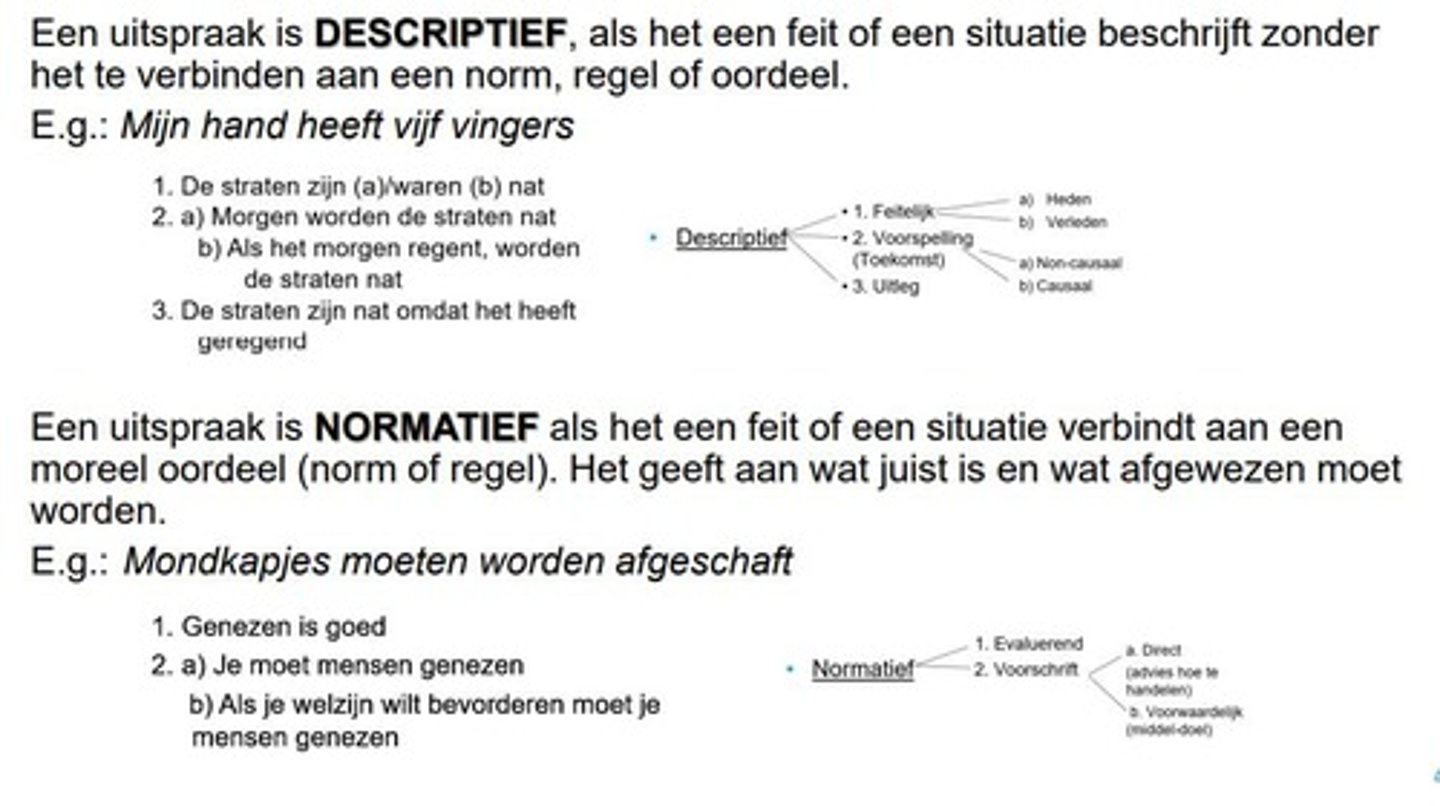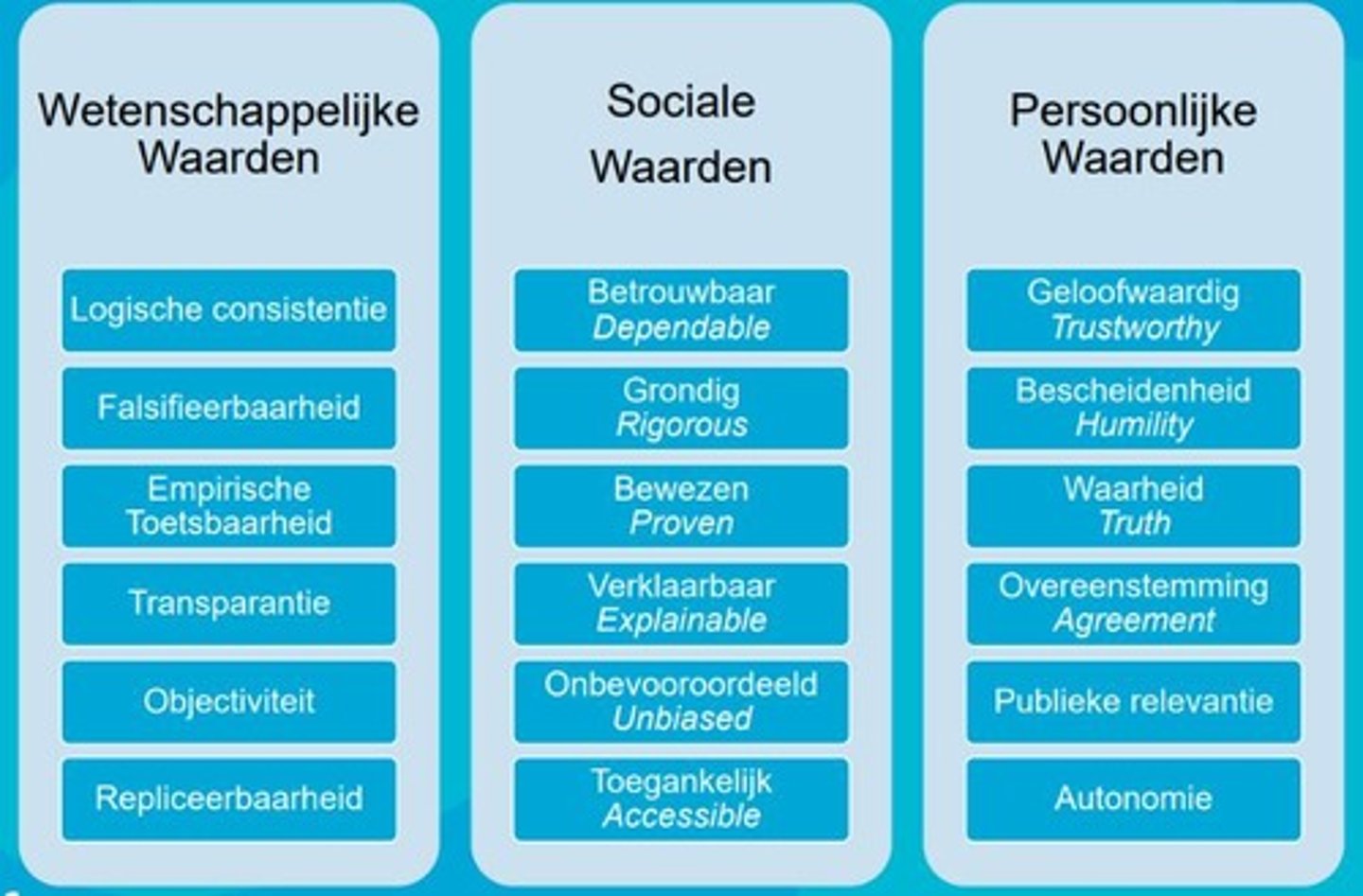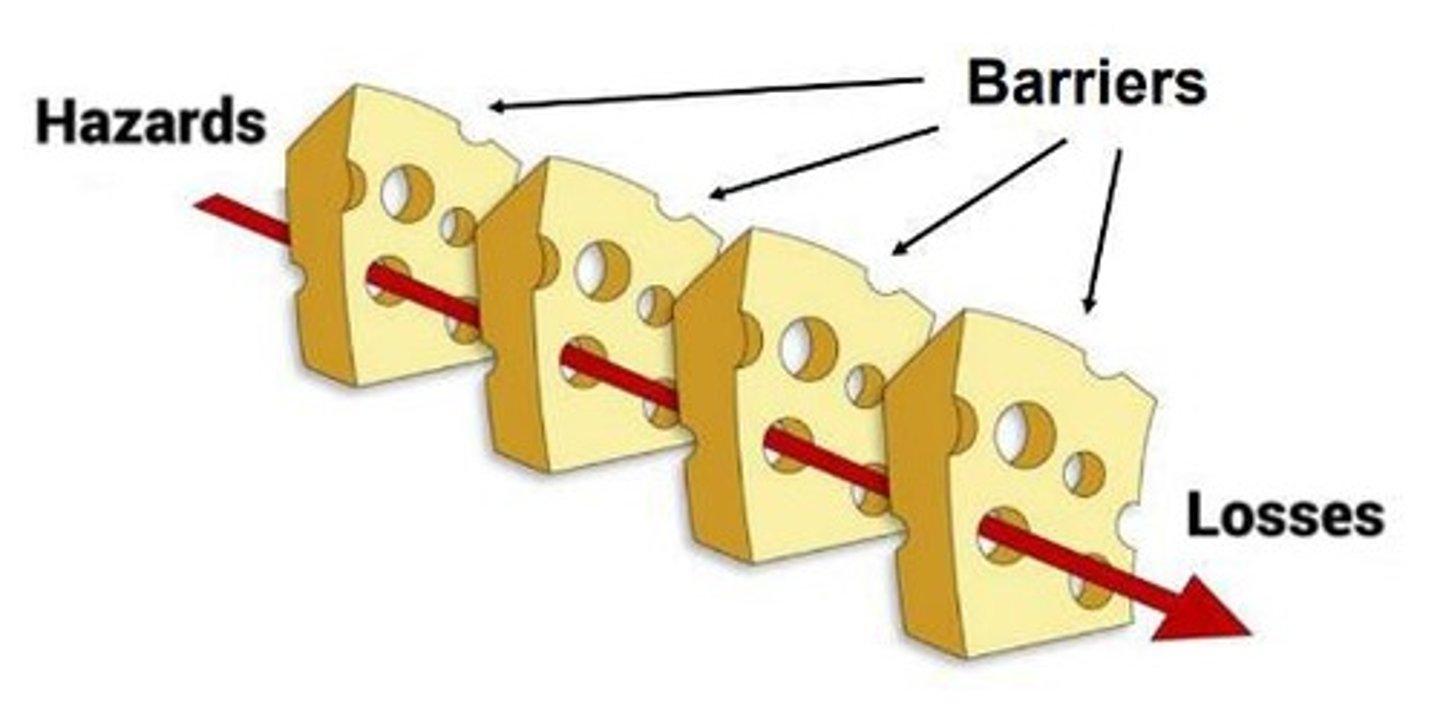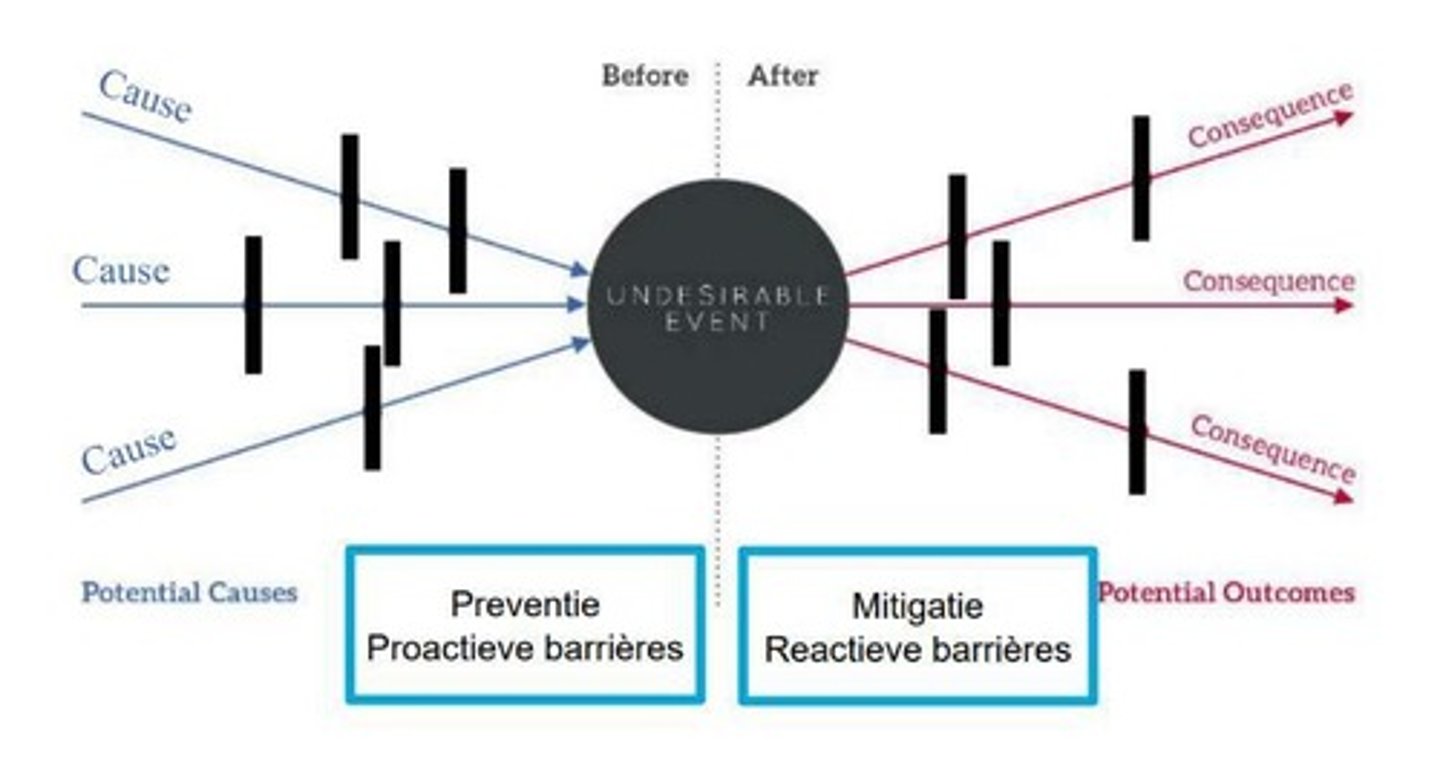Ethiek en Veiligheid: Kernconcepten en Argumentatie | Quizlet
1/98
There's no tags or description
Looks like no tags are added yet.
Name | Mastery | Learn | Test | Matching | Spaced |
|---|
No study sessions yet.
99 Terms
What does Popper state about true science?
True science is falsifiable.
What is the hypothetical-deductive method?
It involves formulating a hypothesis that can be tested through experiments or observations to demonstrate that a theory is false.
What is a valid argument?
An argument where the conclusion logically follows from the premises, even if the premises are not true.
What is a sound argument?
An argument that is both valid and has all true premises.
What are the components necessary for good science?
Reasons, evidence, arguments, methods, justification, and motivation.
What is deductive reasoning?
A form of reasoning where the conclusion logically follows from the premises; if the premises are true, the conclusion must be true.
Provide an example of deductive reasoning.
Premise 1: All dogs have legs. Premise 2: Fido is a dog. Conclusion: Fido has legs.
What is inductive reasoning?
A form of reasoning that draws general conclusions based on specific observations, which does not guarantee a correct conclusion.
Provide an example of inductive reasoning.
Premise: Every crow I have seen is black. Conclusion: All crows are black.
What is abductive reasoning?
A form of reasoning that forms a hypothesis that best explains the available evidence.
Provide an example of abductive reasoning.
Observation: The street is wet. Best explanation: It probably rained.
What is a sound argument example?
Premise 1: All mammals have a backbone. Premise 2: A dog is a mammal. Conclusion: A dog has a backbone.
What is a valid argument example?
Premise 1: If it rains, the street is wet. Premise 2: It is raining. Conclusion: The street is wet.
What is an example of an argument where the premises are true but the conclusion does not follow?
Premise 1: Birds can fly. Premise 2: Penguins are birds. Conclusion: Penguins can fly.
What is an example of a valid but not sound argument?
Premise 1: All cats can fly. Premise 2: Felix is a cat. Conclusion: Felix can fly.
What distinguishes a valid argument from a sound argument?
A valid argument has a logical conclusion based on premises, while a sound argument has true premises and a valid conclusion.
What is the role of examples in reasoning?
Examples help clarify the types of reasoning and illustrate how arguments are constructed.
What is the difference between deductive and inductive reasoning?
Deductive reasoning guarantees the truth of the conclusion if the premises are true, while inductive reasoning provides a probable conclusion based on evidence.
How does abductive reasoning differ from deductive and inductive reasoning?
Abductive reasoning seeks the best explanation for observed evidence, rather than guaranteeing a conclusion or drawing generalizations.
What is the significance of justification in scientific arguments?
Justification provides the rationale for why certain premises are accepted as true in constructing arguments.
Why is it important to differentiate between valid and sound arguments?
Understanding this distinction helps in evaluating the strength and reliability of arguments in scientific discourse.
What is the importance of methods in scientific inquiry?
Methods provide systematic approaches to gather evidence and test hypotheses.
How can reasoning types influence ethical decision-making?
Different reasoning types can lead to varying conclusions about what is considered ethical or safe in practice.
What is the relationship between ethics and safety in scientific contexts?
Ethics guides the responsible conduct of research and application of scientific knowledge, ensuring safety and integrity.
Waarom is wetenschappelijke validiteit belangrijk?
Wetenschappelijke validiteit garandeert dat de resultaten betrouwbaar en accuraat zijn, wat leidt tot reproduceerbare resultaten en logische conclusies.
Wat zijn de gevolgen van het ontbreken van validiteit in onderzoek?
Zonder validiteit verliest wetenschappelijk onderzoek zijn doeltreffendheid en betrouwbaarheid.
Wat is maatschappelijk waardevol onderzoek?
Onderzoek dat praktische toepassingen of betekenis heeft voor de samenleving, zoals oplossingen voor sociale, economische of ecologische problemen.
Hoe kan maatschappelijk waardevol onderzoek invloed hebben op beleidsvorming?
Het kan nieuwe inzichten verschaffen die beleidsvorming en besluitvorming in verschillende sectoren beïnvloeden.
Wat is het verschil tussen een beschrijvende en een normatieve zin?
Een beschrijvende zin gaat over feiten en wat is, terwijl een normatieve zin gaat over wat zou moeten zijn volgens normen en waarden.

Kunnen beschrijvende uitspraken worden geverifieerd?
Ja, beschrijvende uitspraken kunnen worden getoetst en geverifieerd.
Geef een voorbeeld van een beschrijvende uitspraak.
"Het regent vandaag in Amsterdam."
Geef een voorbeeld van een normatieve uitspraak.
"Mensen zouden meer moeten recyclen."
Wat is een belangrijk kenmerk van normatieve uitspraken?
Normatieve uitspraken zijn vaak subjectief en kunnen variëren tussen personen of culturen.
Wat is de rol van wetenschappelijke validiteit in de ontwikkeling van theorieën?
Het stelt de wetenschappelijke gemeenschap in staat om resultaten te gebruiken om bestaande theorieën te ondersteunen, te weerleggen of aan te passen.
Waarom is het belangrijk dat onderzoek goed ontworpen is?
Een goed ontworpen onderzoek volgt de principes van de wetenschappelijke methode, wat bijdraagt aan de validiteit.
Wat betekent het dat resultaten reproduceerbaar zijn?
Het betekent dat andere onderzoekers dezelfde resultaten kunnen verkrijgen onder dezelfde omstandigheden.
Hoe kan maatschappelijk waardevol onderzoek de wereld verrijken?
Het kan nieuwe inzichten verschaffen in menselijk gedrag, cultuur of geschiedenis.
Wat is een voorbeeld van een sociale kwestie die maatschappelijk waardevol onderzoek kan adresseren?
Toegang tot basisgezondheidszorg.
Wat is een kenmerk van beschrijvende uitspraken?
Ze beschrijven de werkelijkheid of een situatie zoals die is.
Waarom is het belangrijk om onderzoek te doen dat maatschappelijk waardevol is?
Het levert resultaten op die praktische toepassingen hebben voor de samenleving.
Wat zijn de principes van de wetenschappelijke methode?
De principes omvatten systematische observatie, hypothesevorming, experimentatie en validatie.
Wat kan het effect zijn van maatschappelijk waardevol onderzoek op de samenleving?
Het kan bijdragen aan het vinden van oplossingen voor belangrijke maatschappelijke problemen.
Waarom zijn beschrijvende uitspraken belangrijk in onderzoek?
Ze bieden een basis voor feitelijke observaties die geanalyseerd en begrepen kunnen worden.
Wat is een voorbeeld van een normatieve vraag?
"Is het rechtvaardig dat sommige mensen geen toegang hebben tot basisgezondheidszorg?"
What are the scientific values mentioned in the notes?
Logical consistency, falsifiability, empirical testability, transparency, objectivity, and replicability.

What are the moral acceptable risks according to the notes?
Informed consent, balance between risks and benefits, possible alternatives, and fair distribution of risks.
How does legislation differ from morality?
Safety standards can limit options and aid decision-making, but following the law does not guarantee moral correctness.
What is a premise in the context of an argument?
A premise is a statement or assertion from which an argument is constructed.
What is an argument?
An argument is a reasoning process where certain statements provide evidence for others; a hypothesis is an estimate of the conclusion.
What is a deductively formulated conclusion?
A hypothesis that provides conditions for a test, meaning the theory is falsifiable.
What are the three components of safety?
Hazard (intrinsic property of an object, process, or situation), exposure (contact between a hazard and a potential harm bearer), and unwanted consequences (impact on health, environment, or financial losses).
What are the three components of security?
Threat (intelligent adversary and types of threats), vulnerabilities (weaknesses that can be exploited), and unwanted consequences (similar to safety).
What does risk estimation involve?
Assessing the likelihood of an unwanted event due to exposure between a hazard and a potential harm bearer, considering both probability and possible impact.
What questions are considered in safety scenarios?
What can go wrong? How can it happen? What are the possible consequences? What is the likelihood? What barriers (control measures) exist?
What is the Swiss cheese model proposed by James Reason?
A model illustrating that barriers can fail, leading to potential hazards.

What is the purpose of the bow-tie model in risk management?
To illustrate preventive, proactive barriers that prevent unwanted events and mitigating, reactive barriers that limit consequences.

What are some examples of preventive barriers in the bow-tie model?
Security by design, substitution of hazards, reducing exposure, avoiding complexity, and removing damage carriers.
What are mitigating barriers in risk management?
Barriers that limit the consequences of an event.
What is an example of a mitigating measure?
An airbag in a vehicle.
What are the two main types of barriers in risk management?
Technical and non-technical barriers.
What are non-technical barriers in risk management?
Organizational procedures, policies, rules, and human factors such as training and education.
What is risk management?
A systematic and continuous process of identifying and evaluating risks and implementing measures to control them.
What are the phases involved in the risk management cycle?
Identification of risks, objective evaluation, and risk treatment.
What does the identification phase of risk management involve?
Identifying new risks, changes in existing risks, and considering different phases such as design, construction, operational, and decommissioning.
What is involved in the objective evaluation of risks?
Estimating the probability and possible consequences of identified risks while considering the context.
What techniques are available for risk evaluation?
Qualitative and quantitative techniques such as Fine & Kinney, What-if analysis, HAZOP, FMEA, and FTA.
What are the options for risk treatment?
Avoiding the risk, transferring the risk, accepting the risk, or reducing the risk.
What does the precautionary principle state?
If there is potential harm from an activity and uncertainty about impacts, anticipatory action should be taken to avoid harm.
How do subjective factors influence risk evaluation?
Subjective factors such as emotions, perceptions, and feelings play a significant role in how risks are evaluated.
What can shape subjective factors in risk perception?
Government regulations, public opinion, media, and education.
What is uncertainty in the context of risk?
A situation that cannot be expressed as 'risk' due to a lack of knowledge or data.
What are some causes of uncertainty?
Novelty, lack of good testing methods, long-term effects, and interaction effects.
What is active responsibility in the context of uncertainty?
Being proactive and forward-looking in managing risks.
What ethical considerations are involved in risk management?
Risk ethics, including deontological and care ethics, which address how people perceive risks and safety.
What does Critical Technology Assessment (CTA) focus on?
The consequences and utilitarian aspects of technology and its risks.
What is the significance of risk acceptance in risk management?
Determining whether a risk is acceptable and deciding on measures to address it.
What is the role of stakeholders in risk management?
Different stakeholders can influence risk perception and acceptance.
What is the impact of public opinion on risk management?
Public concerns and opinions can shape how risks are evaluated and managed.
What is the goal of involving social actors in the decision-making process regarding technological innovations?
To achieve optimal alignment between technological and social developments.
What does Value Sensitive Design (VSD) aim to address in technology research?
It provides insight into whether a technology is beneficial or harmful to society and incorporates stakeholder perspectives for regulation and usage decisions.
What role do ethicists play in research teams according to Value Sensitive Design?
Ethicists are included in research teams to address ethical issues that arise during the research, innovation, development, and application processes.
What is Responsible Research and Innovation (RRI)?
A framework that emphasizes ethical considerations, including anticipation, reflexivity, inclusivity, and responsiveness in research.
What are the four aspects of Responsible Research and Innovation (RRI)?
Anticipation, Reflexivity, Inclusivity, Responsiveness.
When should Responsible Research and Innovation (RRI) be applied?
When research focuses on interactions between developers, governance, and citizens, or when studying innovations that will play a larger role in the future.
What is the focus of Safe-by-Design (SbD)?
To identify and mitigate risks in the early development stages, such as during R&D, by consulting a range of stakeholders.
What are the three types of safety measures mentioned?
Procedural (safety protocols), Engineered (active safety measures), and Inherent (using material properties to reduce risks).
What is the Collingridge Dilemma?
It refers to two problems: the information problem (difficulty in assessing consequences until a technology is developed) and the control problem (difficulty in changing a technology once it is integrated into society).
What is the difference between passive learning and active learning regarding uncertain risks?
Passive learning occurs through accidents and regrettable substitutions, while active learning involves setting up specific procedures and research to understand uncertain risks.
What are Inherent Safety Principles (ISPs) and where are they commonly applied?
ISPs are strategies used to reduce risks, often applied in the chemical industry.
What are the four strategies of Inherent Safety Principles (ISPs)?
Minimization (using smaller quantities of hazardous substances), Substitution (replacing materials with less hazardous ones), Moderation (using less hazardous conditions), and Simplification (designing to eliminate unnecessary complexity).
What ethical considerations arise during the process of research and innovation?
Ethical issues related to values and their implications for citizens, and the necessity for collaboration among different groups.
What is the significance of stakeholder involvement in Safe-by-Design (SbD)?
It helps identify and assess potential risks in early stages of development.
What does the term 'design-based' solution refer to in the context of ethical decision-making?
It refers to solutions that require collaboration among various groups to address ethical concerns.
How does the concept of reflexivity apply to Responsible Research and Innovation (RRI)?
Reflexivity involves critically reflecting on the research process and its implications for society.
What is the purpose of anticipating risks in the context of Safe-by-Design (SbD)?
To proactively identify and reduce or circumvent risks before they manifest.
Why is it challenging to control or change a technology once it is in use, according to the Collingridge Dilemma?
Because once a technology is integrated into society, it becomes difficult to alter its course or impact.
What does the term 'regrettable substitution' refer to in learning about uncertain risks?
It refers to learning from accidents that occur due to poor substitutions of materials or processes.
How can the properties of materials contribute to inherent safety?
By using materials with less toxic properties or reducing the complexity of processes to minimize risks.
What is the iterative nature of Safe-by-Design (SbD)?
It involves continuously assessing and refining safety measures throughout the development process.